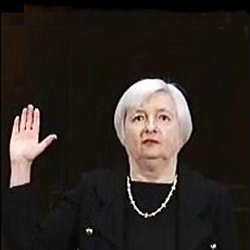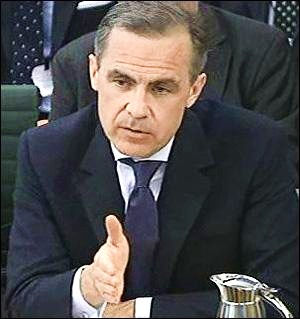By Pam Martens: March 20, 2014
The head of the Bank of England (BOE), Mark Carney, who also chairs the G20’s Financial Stability Board, has a very different view from the U.S. Fed on how to exit stimulus programs. Carney is credited with successfully guiding Canada, where he previously served as head of the central bank, through the worst of the global financial crisis from 2008 to 2010. Does Carney know something that monetary policy wonks in the U.S. don’t or does the Fed know something the rest of us don’t?
In her debut press conference yesterday after taking the reins at the Federal Reserve Board of Governors on February 3 of this year, Janet Yellen jolted markets with the assessment that the Fed’s mammoth, monthly bond buying program, known as quantitative easing (QE), might end as early as this fall. Then, when asked how long after that the Fed might wait before it raised interest rates, Yellen said “it probably means something on the order of six months or that type of thing.”
Markets trade not on what is occurring today, but on the composite perception of what will be happening six months out. Thus, there was an immediate repricing of expectations, pushing stock prices down as their dividend yield looked less attractive to bond yields, which immediately moved upward on anticipation of higher rates sooner than expected.
The Fed’s Federal Open Market Committee also announced another tapering of $10 billion per month in the bond buying program (QE), making that the third taper in as many months and reducing the stimulus from $85 billion a month at the end of last year to $55 billion beginning in April. The Fed has yet to make a move on raising interest rates, however.
Carney, on the other hand, testified on March 11 of this year to Parliament’s Treasury Select Committee that he wouldn’t even consider a reduction in the U.K.’s quantitative easing program until after the Bank of England had raised interest rates. The exchange was as follows:
Andrea Leadsom: “The previous governor said that when the time came to tighten interest rates – base rates — would be changed by about a quarter of a percent and upwards and then quantitative easing would start to be unwound. Is that still your view or absolutely not?”
Carney: “I don’t recall exactly what my predecessor said. My personal view would be that it would be most appropriate to adjust interest rates to a greater degree than that before we considered adjustment in the quantitative easing program. That’s based on a sense of – a pragmatic sense of – where we would have flexibility. So, in other words, if time comes to tighten monetary policy, we should start with, in my view, we should start with bank rate; we should tighten it as appropriate; we should maintain the ability to adjust it down as well as up if subsequent events — a shock to the economy — whatever happens occasion a need to provide stimulus after the initial tightening. I think it would be more difficult to adjust the quantitative easing program in both directions. So we should create some room so we have some flexibility before we start to move on quantitative easing.”
Why the stark difference between the Fed and the BOE? Two likely reasons come to mind. As of the end of last year, before its first taper, the Fed was pumping over $1 trillion into markets through its QE program. The Fed, privately, had begun to observe that this massive liquidity was not being loaned out by the big banks to solid U.S. businesses to stimulate job growth but rather to hedge funds who were inflating emerging markets through speculative bets and fueling a tech bubble here at home reminiscent of 1999. As the U.S. crisis in the long-term unemployed and labor participation rate flashed warning signals, the Fed realized it had little to show for its $4 trillion balance sheet other than larger bonuses on Wall Street and ever greater income inequality — which is restraining consumer spending and further exacerbating job growth.
The second reason is that the Fed, unlike Carney and the BOE, appears to have decided it does not have to worry about ramping up or re-deploying a new round of QE should the economy turn south. It wants to end this dog and pony show and content itself with rolling over the interest and principal payments of a $4 trillion balance sheet into new bonds – a form of QE in and of itself.



